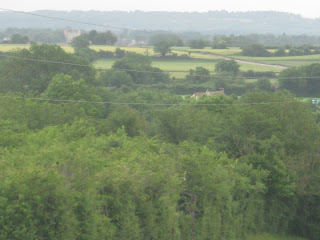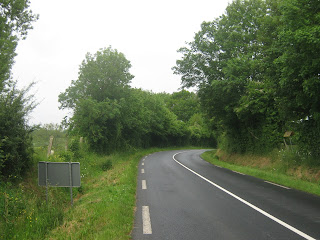Last
day and we looked into the last days of the Normandy campaign – the Falaise
Pocket.
First
we stopped to look at the Trun-Chambois gap, the very narrow stretch of land
where the German forces had to traverse under artillery and direct fire. It
didn’t sound too bad, the gap between the Allied forces were some five kilometres.
When you see it you understand how narrow that is, especially considering that
the Allied forces had the higher ground.
We stop on the hill near Trun, looking over
the gap. The little town below us saw heavy fighting. Can you see the castle in
the distance? Above the bus.
It’s near the horizon, in the middle of the
picture.
Now? Between the phone-lines, near the horizon, 1/4 in from the left.
OK,
between here and there is where the German VII:th Army tried to escape, under
constant fire. You can see nearly everything in between, the only cover is some
small wood here and there, and some hedges. Approximately 10 000 people died
around here.
Close-up of the castle.
After
this we went to Montormel. This hill plugged the gap more or less, and was held
several days by Polish troops, the First Polish Tank Division (the remnants of the
Black Brigade, the Polish armoured unit that fought valiantly and successfully in Poland, escaped the
fall and continued fighting on the Allied side in France, escaped that fall,
and was reborn as an armoured division). Mont Ormel was under more or less constant
attack, and hampered the German movements immensely.
View over the gap
Greyhound Armoured car
Sherman named after the commander of the
division
A visit to the memorial followed, another
nice museum, where we had far too little time to spend.
After
this our bus took us to Paris and the airport and home…. Or so we thought. The
French air controllers didn’t think so. They went out in a one day strike,
effectively shutting down air traffic over France.
That
meant about 1000 cancelled flights from Paris, and a horde of stranded people
needing somewhere to sleep and needing to travel home some other day. Our guide
spent a couple of hours trying to get us somewhere to sleep that was not a sofa
in the airport and a flight home.
We
ended up in a luxurious hotel a couple of blocks from Arc de Triomphe. Not too
bad, considering. Jan and I had a nice dinner, a nice walk and an even nicer
beer at Champs-Elysées.
Big
Lee, at BigLee’s Miniature Adventures, is having a great giveaway. The
reason: 1 000 000 hits since he started the blog. Quite an
achievement, but considering all the good stuff he writes it is not surprising.
So
hop over to his site and join the fun, be it the giveaway or even better the
content of the site.
Rest of the trip:





















































